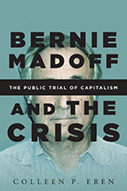Bernie Madoff And The Crisis: The Public Trial Of Capitalism

Author: Colleen P. Eren
Publisher: Stanford, CA: Stanford Business Books, 2017. 210 p.
Reviewer: David Schultz | May 2018
Bernie Madoff’s conviction in 2009 for operating what was then the largest Ponzi scheme in American history came as a surprise to many. What caused the surprise was his role as past chair of NASDAQ, his ethical reputation among many, and his apparent skill as an investor. But revelations of his estimated $60 billion plus scheme that defrauded nearly 5,000 investors came at about the same time that the US and world economy collapsed, partly as a result of the mortgage meltdown and allegations of fraud among banks and investment houses. Because Madoff’s crimes came to light simultaneously with these other events, he became the face of capitalism gone bad, making his prosecution one about the very integrity of the free market. At least this is the claim of the author.
Colleen Eren casts the Madoff Ponzi scheme in light of multiple metaphors. By that, she performs a content analysis of media and news accounts of Madoff and finds that there were several story lines used to describe him and what he did. Some of these story lines were not accurate, or falsely analogized Madoff to the larger economic crisis. This book explores these metaphors.
The book opens by describing the almost unfathomable scale of the economic collapse in 2008. Reporters and the public were looking for a villain, and Madoff was the perfect foil. Repeatedly Madoff is corrupt capitalism personified–the devil, an evil person, who is perhaps singularly responsible for the Great Recession. He is the Tony Soprano of Wall Street, a businessman who is a crook, with his wife and family also real life characters taken from the Sopranos.
A second metaphor or story line was blaming the regulators, specifically the Securities and Exchange Commission (SEC), for Madoff and the financial meltdown. The SEC was faulted as corrupt and inept, not present and ready to do its job. Make no mind that the SEC was not responsible for banks, and that Congress had repealed the Glass–Steagall Act. Nor did the news grasp the way the secondary loan markets operated or how both presidents Clinton and then Bush pushed hard for home ownership, thereby adding fuel to the drive to issue mortgages and then pass them to others to guarantee. The media largely missed how so much of what happened was perfectly legal or, more important, had nothing to do with what Madoff did.
A third story line is how Madoff became the 2000s poster child for “Greed is good.” Taking off from the famous speech of the character Gordon Gekko in Wall Street, the story was that the crisis of 2008 is simply about rich greedy people wanting even more. It is about Madoff–a rich person seeking to make ridiculous amounts of money for other rich greedy people—who brought the financial markets down. But he is only the most famous of all the other greedy rich bankers, investors, and institutions who also were wrong to want to make money. For a brief moment it appeared that the very logic of capitalism, the pursuit of profit, was on trial with Madoff. Securing his guilt and jailing him would send a message to others that there limits to capitalist accumulation and greedy capitalists had better watch out. Of course, as we have come to see, Madoff’s 150-year sentence was symbolic; at 71 he would never serve more than a fraction of it and under Bush and Obama, no one directly responsible for any of the bank collapses would ever be indicted. The length of his sentence, thus, was yet another metaphor in the news–excessive greed deserved excessive punishment.
The book closes by asking what changed or remained the same as a result of Madoff and the Great Recession. Published in 2017 as Donald Trump was becoming president and the U.S. economy was years into a recovery, the author discusses the passage of Dodd-Frank and other financial regulations that were adopted. Yet many of the regulations have now been weakened, failed to address the socio-psychological or institutional forces that led Madoff, others, or institutions to do what they did. Simply put, Madoff’s gigantic fraud led to confused regulation that failed to understand the larger causes and consequence of the Great Recession. Regulation in light of the various Madoff metaphors failed to develop a coherent approach to white-collar crime by assuming that what led to the 2008 crash could be solved simply by jailing one person.
Bernie Madoff and the Crisis is a brief, engaging book that reminds readers about the complexity of social and economic problems and the mistake in simplifying them and thinking that criminal law alone can resolve them.
David Schultz, Professor, Department of Political Science, Hamline University, St Paul, MN, 55104.


